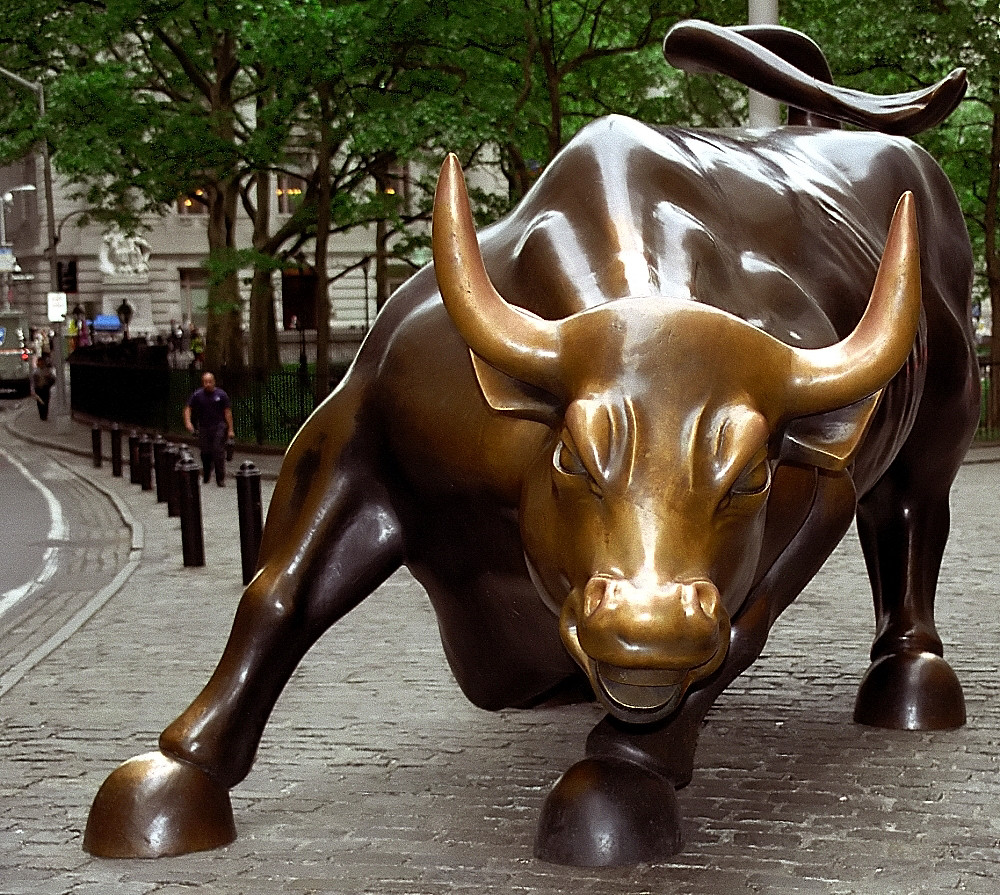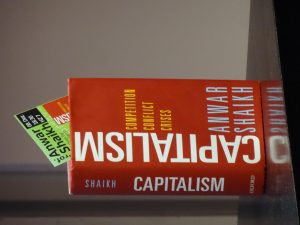Marx, Keynes, Hayek and Minsky on Economic Crises: Room for Agreement?
✑ NICK JOHNSON | ± 12 min
‟On the theory of why economic crises occur, there is some common ground between them all.
On economic policy, these four influential thinkers part ways. But on the theory of why economic crises occur, there is some common ground between them, in terms of imbalances between production and consumption.
Originally published by The Political Economy of Development (Sept. 20, 2018).
|
|---|
About the author (click)
Nick Johnson has an MSc in development economics from SOAS, University of London, works for a charity, is passionately interested in economics and how it can be used to promote sustainable human progress. His personal blog: The Political Economy of Development. On twitter: @nickj_econ.
At first glance, it would seem fanciful that the theories of Karl Marx and Friedrich Hayek could be drawn on together to explain economic crises, or cycles, booms and busts. Certainly, the two men’s politics could not have been more different: Marx predicted (and hoped for) either the collapse or the overthrow of capitalism and its replacement by socialism and communism. Hayek thought that most kinds of state intervention in the market were the thin end of the authoritarian wedge.
The ideas of John Maynard Keynes and Hyman Minsky are more compatible, and both have many disciples in the post-Keynesian school. Minsky developed Keynes’ theory of investment and its role in instability under capitalism. For Keynes and Minsky then, capitalism is inherently unstable, money and finance play a large role in this instability and it is the job of government to save the system from itself.
On economic policy, these four influential thinkers part ways. Marx offered little theory of policy; Hayek, like others in the Austrian school, rejected it as damaging and favoured a laissez-faire approach; Keynes and Minsky were interventionists.
But on the theory of why economic crises occur, there is some common ground between them all, which I hope to expound below. In this I have been inspired by the writing of Professor Michael Pettis, who blogs here, and whose three books on financial instability, the imbalances that led to the Great Recession of 2008, and China’s economic restructuring, are well worth reading.
In The Great Rebalancing (p.3), Pettis argues that:
For the economy as a whole, the difference between total production, or GDP, and total consumption, is equal to total savings. In a hypothetical closed economy, total savings is equal to total investment, while in an economy open to international flows of goods, services and capital, they can, and typically do, differ.
Keynes and investment-savings
Keynes’ magnum opus, The General Theory, aimed to provide an explanation of persistent unemployment under capitalism. This book adopted a model of a closed economy for simplicity, and argued that insufficient desired investment on the part of entrepreneurs weakened aggregate demand and economic growth below their potential, leading to unemployment. He put it another way: when desired savings, or money not spent, exceeds desired investment, this will weaken economic growth.
In macroeconomics, it is key to distinguish between desired and actual savings or investment. For an individual consumer or entrepreneur, a desire to save more and not spend money may increase their actual savings and wealth. But if all consumers or entrepreneurs in the economy desire to save more at the same time, aggregate demand and growth will weaken, and actual savings and the addition to wealth will fall short of their desired levels, since the economy will be smaller than otherwise, and there will be less total income.
This is known as the paradox of thrift, and is one illustration of how macroeconomic outcomes can differ from microeconomic or individual intentions. It provides a justification for the existence of macroeconomics as a distinct field of study. So ‘over-saving’ can be a cause of unemployment.
Minsky and financial fragility
Minsky took Keynes’ arguments about investment as the driving force of capitalist growth and the instability of finance and developed them further. He argued that periods of strong economic performance will tend to encourage an excessive accumulation of private sector debt and in doing so create financial fragility which will, in the absence of government intervention, lead to instability and crisis.
For Keynes and Minsky, the solution was ‘Big Government’ (fiscal stabilization) and a ‘Big Bank’ (financial regulation by the central bank). Keynes also helped to create the post-war Bretton Woods system of managed international finance, which contributed to more than twenty years of relative stability and rapid recovery and growth in the capitalist world.
Marx and the several causes of crises
Marx anticipated some of Keynes’ arguments in his own magnum opus, Capital, although throughout the work he manages to suggest a number of reasons for economic crises: under-consumption; insufficient profitability of producing firms; and imbalances between investment and consumption, or what Marx called the ‘anarchy’ of capitalist production. This has given rise to much debate, mostly between Marxists, rather than with the mainstream, as to what Marx really said or meant by what he said!
The quote above from Pettis and other passages from The Great Rebalancing seem to boil all this down to the idea of under-consumption, which will probably infuriate those Marxists who remain wedded to Marx’s law of the falling rate of profit, which some say will eventually lead to the collapse of capitalism. But surely profits are partly determined by demand, a major element of which is consumption spending. Over-saving or under-consumption can lower profits at level of the overall economy. As just explained in reference to Marx’s own thinking, this is a crisis of the ‘realisation’ of profits.
Hayek and malinvestment
For Hayek and followers of the Austrian school, financial and economic crises are caused by mistaken government policies which encourage ‘malinvestment’. The latter refers to investment in projects which ultimately prove to be unprofitable so that economic resources are misallocated. This can occur in all sorts of historically contingent ways, but in the case of the recent crisis, interest rates were kept too low by the central bank, in particular the Federal Reserve, encouraging an excessive expansion of credit which, along with policies which encouraged poor families to take out mortgages, fueled unproductive investment in housing. When the housing market turned, and it became apparent that many of these mortgages could not be repaid, the bubble collapsed, and investment fell, causing the downturn.
Austrian economists reject the need for government intervention to mitigate economic crises since they believe that they are caused by misguided policies in the first place, and that further ‘meddling’ will only make things worse. The crisis is seen as a sort of cleansing process in which, in the absence of intervention, resources will ultimately be reallocated by the market towards more productive uses, and a recovery will follow.
Something similar can be found in Marx’s ideas on profitability, in which a crisis caused by insufficient profitability forces weaker or less profitable firms out of business, and rising unemployment weakens the bargaining power of workers and reduces wages, helping to restore profits and the motivation for a new phase of rising investment and growth to begin. Government policies which try to prevent or mitigate the crisis will prevent this economic restructuring from taking place and, while they might reduce the severity of the crisis, may lower longer-run growth if profits are lower than they otherwise would be.
So there is some common ground between Marx and Keynes, and Marx and Hayek, and plenty between Keynes and Minsky.
On policies to prevent or mitigate crises, Marxists, Keynesians, and Austrians are poles apart. But if we go back to the quote by Pettis, and consider that crises are caused by ‘imbalances between production and consumption’, then I would argue that, on explanations of the causes, there are indeed some points of agreement.
Once more, the difference between production and consumption is savings, which can accrue to private firms, as a potential source of investment; to private households; or to the government. In a closed economy, excess savings, sometimes called a ‘savings glut’ or, by implication, ‘under-consumption’, will tend to weaken growth in Keynesian fashion. Alternatively, they may find their way into speculative investments, at least initially.
However, in an open economy, these excess savings, which will be reflected in a current account surplus, can be exported or lent abroad as flows of capital, providing a source of productive or unproductive investment, or consumption, in the economy which absorbs the savings. This will reduce net savings, or the difference between savings and investment, in said economy, increasing demand and growth in the short run, with the longer-run outcome depending on how the borrowed capital inflows are spent.
The Austrian theory of business cycles, with its theory of malinvestment, lays the blame at the door of a government policy of excessively low interest rates, which stimulate unproductive credit-fueled investment spending. But what makes this investment unproductive? It is unproductive relative to the amount of spending on consumption. Investment will only prove to be poorly allocated if it provides more capacity for production than can be absorbed by the current level of domestic consumption.
Note that this investment and consumption spending can be driven by the private sector or the government, and either can be efficiently or inefficiently allocated, although this point is certainly not to be found in the thinking of the Austrian school.
Where Marx, Keynes and Minsky differ radically from Hayek and the Austrians is on the role of government. Hayek blames government policy for crises, while the others hold them to be endogenous (caused from within the system itself).
Pettis refreshingly draws on the overlapping ideas of these thinkers, but employs them in a theory of the global economy, with imbalances between savings and investment at the country level impacting on countries abroad via the balance of payments.
But for Pettis, it is inequality, broadly conceived, which causes the imbalance between production and consumption. If the distribution of income and wealth is particularly unequal this will tend to raise the savings rate, since wealthier groups consume a lower proportion of their income than poorer ones.
Investment spending can be constrained by either savings or consumption. If it is the latter, then rising inequality and the resultant excess savings and under-consumption will reduce the incentive for firms to invest. If the former, then rising inequality will generate the higher savings needed to fund higher investment.
These ideas can be found in Keynes’ General Theory, in which he argues that in a closed economy at full employment, higher investment requires higher savings which can only be created by reducing consumption. However, at less than full employment, higher investment may be stimulated by higher consumption via the multiplier. What Keynes called the ‘propensity to consume’ could be increased by reducing inequality. Thus, as he put it, the ‘outstanding faults’ of a capitalist economy, unemployment and inequality, could be reduced together, since they need not be in conflict, at least up to a point.
Inequality can thus be a cause of a crisis induced by a savings glut, and can be changed via government intervention. All this is far removed from Austrian business cycle theory, which ignores the theme of inequality. For the Austrian school, excessively low interest rates create the imbalance between production and consumption. But if increased inequality weakens growth, then for a central bank such as the Federal Reserve, with its mandate to keep both inflation and unemployment low, then if inflation is on target, but unemployment is rising, it will cut interest rates to boost growth, as it did in the early 2000s.
Austrians and some Keynesians argue that this created the subsequent debt-driven housing bubble, which restored economic growth but placed it on an unsustainable footing. So there is some further agreement here between these two schools, albeit giving rise to different policy implications.
Some Austrians would want interest rates to be determined entirely by the market, and to abolish fractional reserve banking, while the Keynesians would argue for policies to redistribute income and wealth in order to reduce inequality.
But if inequality is a cause of crises, then the Austrian response would fail to restore economic growth and stabilize the economy. The Keynesian or post-Keynesian solution of reducing inequality would be more effective.
In the absence of such rebalancing, global aggregate demand will depend on the unsustainable accumulation of debt among economies running current account deficits such as the US.
Finally, while some may object to lumping (elements of) the theories of Marx, Keynes, Hayek and Minsky together in explaining economic crises, I think there is something to gain from this exercise. There is some common ground between them, although I admit that this is at quite a general level, in terms of imbalances between production and consumption. At the same time, Marxists, Keynesians and Austrians part ways significantly when it comes to politics and policy recommendations.
The ideas of John Maynard Keynes and Hyman Minsky are more compatible, and both have many disciples in the post-Keynesian school. Minsky developed Keynes’ theory of investment and its role in instability under capitalism. For Keynes and Minsky then, capitalism is inherently unstable, money and finance play a large role in this instability and it is the job of government to save the system from itself.
On economic policy, these four influential thinkers part ways. Marx offered little theory of policy; Hayek, like others in the Austrian school, rejected it as damaging and favoured a laissez-faire approach; Keynes and Minsky were interventionists.
But on the theory of why economic crises occur, there is some common ground between them all, which I hope to expound below. In this I have been inspired by the writing of Professor Michael Pettis, who blogs here, and whose three books on financial instability, the imbalances that led to the Great Recession of 2008, and China’s economic restructuring, are well worth reading.
In The Great Rebalancing (p.3), Pettis argues that:
“[T]he classic explanation of the origins of crises in capitalist systems, one followed by Marxist as well as many non-Marxist economists, points to imbalances between production and consumption in the major economies as the primary source of monetary instability.”
For the economy as a whole, the difference between total production, or GDP, and total consumption, is equal to total savings. In a hypothetical closed economy, total savings is equal to total investment, while in an economy open to international flows of goods, services and capital, they can, and typically do, differ.
Keynes and investment-savings
Keynes’ magnum opus, The General Theory, aimed to provide an explanation of persistent unemployment under capitalism. This book adopted a model of a closed economy for simplicity, and argued that insufficient desired investment on the part of entrepreneurs weakened aggregate demand and economic growth below their potential, leading to unemployment. He put it another way: when desired savings, or money not spent, exceeds desired investment, this will weaken economic growth.
In macroeconomics, it is key to distinguish between desired and actual savings or investment. For an individual consumer or entrepreneur, a desire to save more and not spend money may increase their actual savings and wealth. But if all consumers or entrepreneurs in the economy desire to save more at the same time, aggregate demand and growth will weaken, and actual savings and the addition to wealth will fall short of their desired levels, since the economy will be smaller than otherwise, and there will be less total income.
This is known as the paradox of thrift, and is one illustration of how macroeconomic outcomes can differ from microeconomic or individual intentions. It provides a justification for the existence of macroeconomics as a distinct field of study. So ‘over-saving’ can be a cause of unemployment.
 |
| Hyman Minsky (upper left), Friedrich Hayek (upper right), Karl Marx (bottom right) and John Maynard Keynes (bottom left) |
Minsky and financial fragility
Minsky took Keynes’ arguments about investment as the driving force of capitalist growth and the instability of finance and developed them further. He argued that periods of strong economic performance will tend to encourage an excessive accumulation of private sector debt and in doing so create financial fragility which will, in the absence of government intervention, lead to instability and crisis.
For Keynes and Minsky, the solution was ‘Big Government’ (fiscal stabilization) and a ‘Big Bank’ (financial regulation by the central bank). Keynes also helped to create the post-war Bretton Woods system of managed international finance, which contributed to more than twenty years of relative stability and rapid recovery and growth in the capitalist world.
Marx and the several causes of crises
Marx anticipated some of Keynes’ arguments in his own magnum opus, Capital, although throughout the work he manages to suggest a number of reasons for economic crises: under-consumption; insufficient profitability of producing firms; and imbalances between investment and consumption, or what Marx called the ‘anarchy’ of capitalist production. This has given rise to much debate, mostly between Marxists, rather than with the mainstream, as to what Marx really said or meant by what he said!
‟Paying low wages may boost surplus value and profits for an individual firm, but it will weaken consumption demand and profits if all firms attempt to do the same.Another approach to economic cycles and crises which draws on Marx emphasises the tension between the production and realisation of surplus value. For Marx, surplus value in production is the source of profit. Individual capitalists or entrepreneurs want profits to be as high as possible and may therefore try to keep their wage bill low by paying workers as little as possible. But they also want demand for their products to be high which, if they are producing output for consumption, will be higher if other firms are paying high wages. So paying low wages may boost surplus value and profits for an individual firm, but it will weaken consumption demand and profits if all firms attempt to do the same. High profits will not be ‘realised’ if all firms do this. So there is a tension or contradiction in the economic system.
The quote above from Pettis and other passages from The Great Rebalancing seem to boil all this down to the idea of under-consumption, which will probably infuriate those Marxists who remain wedded to Marx’s law of the falling rate of profit, which some say will eventually lead to the collapse of capitalism. But surely profits are partly determined by demand, a major element of which is consumption spending. Over-saving or under-consumption can lower profits at level of the overall economy. As just explained in reference to Marx’s own thinking, this is a crisis of the ‘realisation’ of profits.
Hayek and malinvestment
For Hayek and followers of the Austrian school, financial and economic crises are caused by mistaken government policies which encourage ‘malinvestment’. The latter refers to investment in projects which ultimately prove to be unprofitable so that economic resources are misallocated. This can occur in all sorts of historically contingent ways, but in the case of the recent crisis, interest rates were kept too low by the central bank, in particular the Federal Reserve, encouraging an excessive expansion of credit which, along with policies which encouraged poor families to take out mortgages, fueled unproductive investment in housing. When the housing market turned, and it became apparent that many of these mortgages could not be repaid, the bubble collapsed, and investment fell, causing the downturn.
Austrian economists reject the need for government intervention to mitigate economic crises since they believe that they are caused by misguided policies in the first place, and that further ‘meddling’ will only make things worse. The crisis is seen as a sort of cleansing process in which, in the absence of intervention, resources will ultimately be reallocated by the market towards more productive uses, and a recovery will follow.
Something similar can be found in Marx’s ideas on profitability, in which a crisis caused by insufficient profitability forces weaker or less profitable firms out of business, and rising unemployment weakens the bargaining power of workers and reduces wages, helping to restore profits and the motivation for a new phase of rising investment and growth to begin. Government policies which try to prevent or mitigate the crisis will prevent this economic restructuring from taking place and, while they might reduce the severity of the crisis, may lower longer-run growth if profits are lower than they otherwise would be.
So there is some common ground between Marx and Keynes, and Marx and Hayek, and plenty between Keynes and Minsky.
On policies to prevent or mitigate crises, Marxists, Keynesians, and Austrians are poles apart. But if we go back to the quote by Pettis, and consider that crises are caused by ‘imbalances between production and consumption’, then I would argue that, on explanations of the causes, there are indeed some points of agreement.
Once more, the difference between production and consumption is savings, which can accrue to private firms, as a potential source of investment; to private households; or to the government. In a closed economy, excess savings, sometimes called a ‘savings glut’ or, by implication, ‘under-consumption’, will tend to weaken growth in Keynesian fashion. Alternatively, they may find their way into speculative investments, at least initially.
However, in an open economy, these excess savings, which will be reflected in a current account surplus, can be exported or lent abroad as flows of capital, providing a source of productive or unproductive investment, or consumption, in the economy which absorbs the savings. This will reduce net savings, or the difference between savings and investment, in said economy, increasing demand and growth in the short run, with the longer-run outcome depending on how the borrowed capital inflows are spent.
The Austrian theory of business cycles, with its theory of malinvestment, lays the blame at the door of a government policy of excessively low interest rates, which stimulate unproductive credit-fueled investment spending. But what makes this investment unproductive? It is unproductive relative to the amount of spending on consumption. Investment will only prove to be poorly allocated if it provides more capacity for production than can be absorbed by the current level of domestic consumption.
Note that this investment and consumption spending can be driven by the private sector or the government, and either can be efficiently or inefficiently allocated, although this point is certainly not to be found in the thinking of the Austrian school.
‟Where Marx, Keynes and Minsky differ radically from Hayek and the Austrians is on the role of government.For Hayek, the theory of malinvestment can be described in terms of an imbalance between investment and consumption which, by implication, is the same thing as an imbalance between production and consumption.
Where Marx, Keynes and Minsky differ radically from Hayek and the Austrians is on the role of government. Hayek blames government policy for crises, while the others hold them to be endogenous (caused from within the system itself).
Pettis refreshingly draws on the overlapping ideas of these thinkers, but employs them in a theory of the global economy, with imbalances between savings and investment at the country level impacting on countries abroad via the balance of payments.
But for Pettis, it is inequality, broadly conceived, which causes the imbalance between production and consumption. If the distribution of income and wealth is particularly unequal this will tend to raise the savings rate, since wealthier groups consume a lower proportion of their income than poorer ones.
Investment spending can be constrained by either savings or consumption. If it is the latter, then rising inequality and the resultant excess savings and under-consumption will reduce the incentive for firms to invest. If the former, then rising inequality will generate the higher savings needed to fund higher investment.
These ideas can be found in Keynes’ General Theory, in which he argues that in a closed economy at full employment, higher investment requires higher savings which can only be created by reducing consumption. However, at less than full employment, higher investment may be stimulated by higher consumption via the multiplier. What Keynes called the ‘propensity to consume’ could be increased by reducing inequality. Thus, as he put it, the ‘outstanding faults’ of a capitalist economy, unemployment and inequality, could be reduced together, since they need not be in conflict, at least up to a point.
Inequality can thus be a cause of a crisis induced by a savings glut, and can be changed via government intervention. All this is far removed from Austrian business cycle theory, which ignores the theme of inequality. For the Austrian school, excessively low interest rates create the imbalance between production and consumption. But if increased inequality weakens growth, then for a central bank such as the Federal Reserve, with its mandate to keep both inflation and unemployment low, then if inflation is on target, but unemployment is rising, it will cut interest rates to boost growth, as it did in the early 2000s.
Austrians and some Keynesians argue that this created the subsequent debt-driven housing bubble, which restored economic growth but placed it on an unsustainable footing. So there is some further agreement here between these two schools, albeit giving rise to different policy implications.
Some Austrians would want interest rates to be determined entirely by the market, and to abolish fractional reserve banking, while the Keynesians would argue for policies to redistribute income and wealth in order to reduce inequality.
But if inequality is a cause of crises, then the Austrian response would fail to restore economic growth and stabilize the economy. The Keynesian or post-Keynesian solution of reducing inequality would be more effective.
‟While some may object to lumping (elements of) the theories of Marx, Keynes, Hayek and Minsky together in explaining economic crises, I think there is something to gain from this exercise.How this is done will depend on where the income and wealth is concentrated. In economies such as Japan and Germany, the corporate sector is a major net saver, so that profits tend to be much greater than investment, while growth in wages and consumption has been too weak. Policies to increase household income and consumption, whether via tax and public spending, or by boosting wages, would help to rebalance these economies. China also needs to rebalance its economy away from poorly allocated investment towards consumption and to reduce its debt burden.
In the absence of such rebalancing, global aggregate demand will depend on the unsustainable accumulation of debt among economies running current account deficits such as the US.
Finally, while some may object to lumping (elements of) the theories of Marx, Keynes, Hayek and Minsky together in explaining economic crises, I think there is something to gain from this exercise. There is some common ground between them, although I admit that this is at quite a general level, in terms of imbalances between production and consumption. At the same time, Marxists, Keynesians and Austrians part ways significantly when it comes to politics and policy recommendations.
























Comments
Post a Comment
Your thoughts...